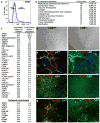Isolation of primitive endoderm, mesoderm, vascular endothelial and trophoblast progenitors from human pluripotent stem cells
- PMID: 22634564
- PMCID: PMC3672406
- DOI: 10.1038/nbt.2239
Isolation of primitive endoderm, mesoderm, vascular endothelial and trophoblast progenitors from human pluripotent stem cells
Abstract
To identify early populations of committed progenitors derived from human embryonic stem cells (hESCs), we screened self-renewing, BMP4-treated and retinoic acid-treated cultures with >400 antibodies recognizing cell-surface antigens. Sorting of >30 subpopulations followed by transcriptional analysis of developmental genes identified four distinct candidate progenitor groups. Subsets detected in self-renewing cultures, including CXCR4(+) cells, expressed primitive endoderm genes. Expression of Cxcr4 in primitive endoderm was confirmed in visceral endoderm of mouse embryos. BMP4-induced progenitors exhibited gene signatures of mesoderm, trophoblast and vascular endothelium, suggesting correspondence to gastrulation-stage primitive streak, chorion and allantois precursors, respectively. Functional studies in vitro and in vivo confirmed that ROR2(+) cells produce mesoderm progeny, APA(+) cells generate syncytiotrophoblasts and CD87(+) cells give rise to vasculature. The same progenitor classes emerged during the differentiation of human induced pluripotent stem cells (hiPSCs). These markers and progenitors provide tools for purifying human tissue-regenerating progenitors and for studying the commitment of pluripotent stem cells to lineage progenitors.
Conflict of interest statement
The authors declare no competing financial interests
Figures







Comment in
-
Taming stem cell heterogeneity.Nat Methods. 2012 Jul;9(7):645. doi: 10.1038/nmeth.2094. Nat Methods. 2012. PMID: 22930832 No abstract available.
Similar articles
-
CXCR4+/FLK-1+ biomarkers select a cardiopoietic lineage from embryonic stem cells.Stem Cells. 2008 Jun;26(6):1464-73. doi: 10.1634/stemcells.2007-0808. Epub 2008 Mar 27. Stem Cells. 2008. PMID: 18369102
-
The migration pattern of cells during the mesoderm and endoderm differentiation from human pluripotent stem cells.In Vitro Cell Dev Biol Anim. 2024 May;60(5):535-543. doi: 10.1007/s11626-024-00904-4. Epub 2024 Apr 24. In Vitro Cell Dev Biol Anim. 2024. PMID: 38656570
-
Distinct Wnt-driven primitive streak-like populations reflect in vivo lineage precursors.Development. 2014 Mar;141(6):1209-21. doi: 10.1242/dev.101014. Development. 2014. PMID: 24595287 Free PMC article.
-
The mouse fetal-placental arterial connection: A paradigm involving the primitive streak and visceral endoderm with implications for human development.Wiley Interdiscip Rev Dev Biol. 2020 Mar;9(2):e362. doi: 10.1002/wdev.362. Epub 2019 Oct 17. Wiley Interdiscip Rev Dev Biol. 2020. PMID: 31622045 Review.
-
Deciphering the hierarchy of angiohematopoietic progenitors from human pluripotent stem cells.Cell Cycle. 2013 Mar 1;12(5):720-7. doi: 10.4161/cc.23823. Epub 2013 Feb 6. Cell Cycle. 2013. PMID: 23388453 Free PMC article. Review.
Cited by
-
Prospective isolation of human embryonic stem cell-derived cardiovascular progenitors that integrate into human fetal heart tissue.Proc Natl Acad Sci U S A. 2013 Feb 26;110(9):3405-10. doi: 10.1073/pnas.1220832110. Epub 2013 Feb 7. Proc Natl Acad Sci U S A. 2013. PMID: 23391730 Free PMC article.
-
NANOG initiates epiblast fate through the coordination of pluripotency genes expression.Nat Commun. 2022 Jun 21;13(1):3550. doi: 10.1038/s41467-022-30858-8. Nat Commun. 2022. PMID: 35729116 Free PMC article.
-
Self-organized vascular networks from human pluripotent stem cells in a synthetic matrix.Proc Natl Acad Sci U S A. 2013 Jul 30;110(31):12601-6. doi: 10.1073/pnas.1306562110. Epub 2013 Jul 15. Proc Natl Acad Sci U S A. 2013. PMID: 23858432 Free PMC article.
-
Polycomb repressive complex 2 shields naïve human pluripotent cells from trophectoderm differentiation.Nat Cell Biol. 2022 Jun;24(6):845-857. doi: 10.1038/s41556-022-00916-w. Epub 2022 May 30. Nat Cell Biol. 2022. PMID: 35637409 Free PMC article.
-
A method to recapitulate early embryonic spatial patterning in human embryonic stem cells.Nat Methods. 2014 Aug;11(8):847-54. doi: 10.1038/nmeth.3016. Epub 2014 Jun 29. Nat Methods. 2014. PMID: 24973948 Free PMC article.
References
-
- Murry CE, Keller G. Differentiation of embryonic stem cells to clinically relevant populations: lessons from embryonic development. Cell. 2008;132:661–680. - PubMed
-
- Xu RH, et al. BMP4 initiates human embryonic stem cell differentiation to trophoblast. Nat Biotechnol. 2002;20:1261–1264. - PubMed
-
- D’Amour KA, et al. Efficient differentiation of human embryonic stem cells to definitive endoderm. Nat Biotechnol. 2005;23:1534–1541. - PubMed
-
- Yasunaga M, et al. Induction and monitoring of definitive and visceral endoderm differentiation of mouse ES cells. Nat Biotechnol. 2005;23:1542–1550. - PubMed
Publication types
MeSH terms
Substances
Grants and funding
LinkOut - more resources
Full Text Sources
Other Literature Sources
Miscellaneous

